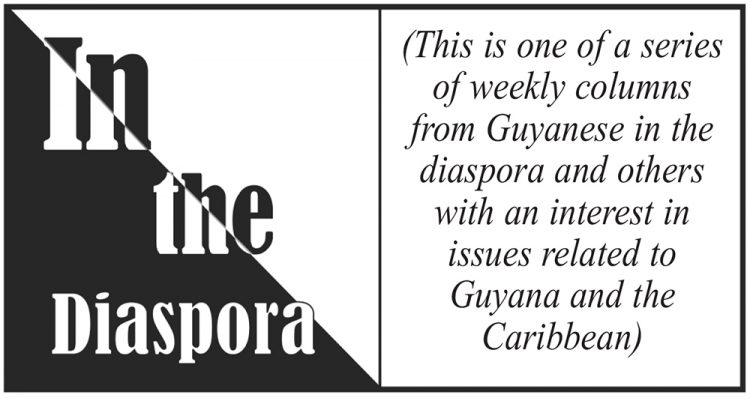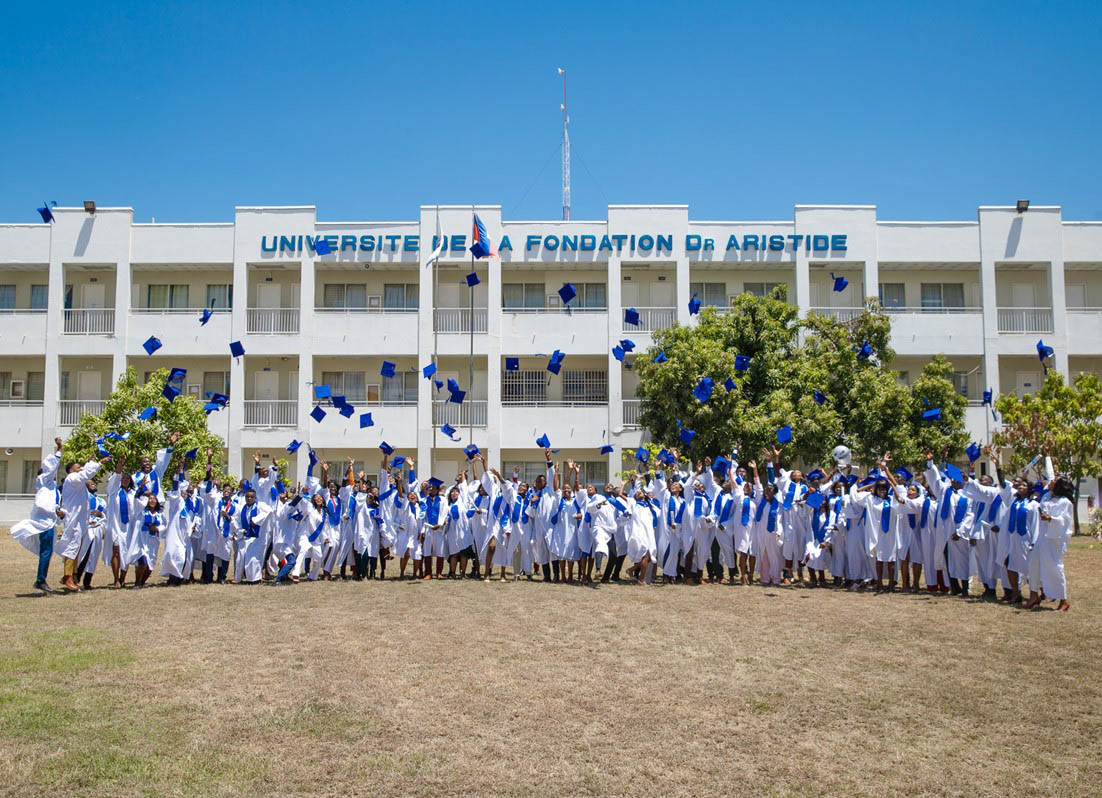
President Jean-Bertrand Aristide joins me in sending his warm regards, with special greetings to the conveners of this weekend’s events, Global Women’s Strike and the new Crossroads Women’s Center. I am here to talk about the work of our university in Haiti, UNIFA – founded by President Aristide in 2002, to explain its importance in fighting poverty, promoting human dignity and offering young people in Haiti a place of hope.
Haiti is facing an unprecedented period of violence, social and political unrest. Every news story is replete with the words: gang violence, kidnappings, killings, hunger, food insecurity. But if I were to take you on campus right now, you would be surprised to see students in class, taking final exams, sitting under a mango tree, talking to a professor. Ordinary images that in the present context of Haiti, are pretty extraordinary.
Haiti has always been a place of contrasts and contradictions. Where the seemingly impossible was just that until it happened. At the height of the most brutal of all slave regimes Haitians led the first successful revolt to become the first Black republic. Yet a recent New York Times article chose to label this fight against slavery as vigilantism writing: “ … Vigilantism in Haiti is nothing new. It was used during the Haitian revolution against the French….” Imagine that, enslaved people fighting for their humanity called vigilantes, not freedom fighters.
UNIFA sits on a national and historic continuum that began with a complete rupture from a regime of enslaved persons considered non-human to a regime of full humanity. Like all countries, Haiti’s trajectory did not follow a straight path. After independence in 1804, Haiti was isolated, surrounded by slave colonies in the Caribbean, slave-owning US to the west and former European colonists to the east. France never gave up hope of re-colonization. Former slave owners pressed their government to restore their colonial wealth, demanding reparations. Which is what the French king gave them. In 1825 armed warships sailed to Haiti bearing an ordinance demanding payment of a 150 million gold francs indemnity – an amount 10 times Haiti’s national budget. The terms were non-negotiable. The alternative was war and the threat of re-enslavement.
A six-part New York Times series published in May 2022 exposed this hidden chapter of Haitian and French history. The journalists calculated that Haiti paid France $560 million, but that the actual cost to Haiti was anywhere between $21 and $117 billion. Economists have long cited this ransom as the cause of the country’s endemic poverty. The brunt of the debt fell on Haiti’s Black rural peasantry. Heavy taxes were levied on agricultural produce – coffee, sugar, indigo and precious wood. A repressive Rural Code was enacted to maximize productivity. There was simply no money left for much of anything else.
Difficulty paying this ransom-debt was the backdrop of Haitian politics through the end of the 19th and into the 20th century. Eighty percent of government revenues went to the debt. Governments rose and fell on their ability to pay French banks, fostering instability and corruption. In 1915, it was the convenient pretext for a US military occupation that endured 19 years. But the real reason was rooted in the Monroe Doctrine: the US wanted to end European interest in Haiti. City Bank of New York in particular wanted a piece of the lucrative Haitian government loans.
Haiti entered the second half of the 20th century with an impoverished rural sector that offered little in the way of government services like healthcare or education. A colour/class divide – akin to South African apartheid – was entrenched. People of the rural countryside were called moun endeyo: people of outside. Their birth certificates – including that of my husband born in the South in 1953, stamped with the word, peasant.
Mid 20th century saw the rise of François Duvalier. He established the tonton macoutes, an armed corps of paramilitaries. During his 14-year reign Duvalier was responsible for up to 50,000 executions. Near the end of his term he amended the constitution twice, first to appoint himself president for life then to name his 19-year old son his successor. All with no real opposition from Haiti’s strongest ally the US.
But in the 1980’s a dynamic democratic movement took root. Members of the ti legliz (people’s church) agitating for social and political change. Popular organizations, women’s groups, labour unions, agricultural cooperatives, youth groups, engaged in literacy and adult education programs; Creole language radio stations disseminated ideas reflecting a new society. The young Catholic priest, Jean-Bertrand Aristide, was a leading liberation theologian and a spokesperson of this movement. In 1986, Duvalier was forced to flee.
After Duvalier a succession of military juntas controlled the government. In December 1991, Haiti organized its first free elections: Aristide won by a landslide, becoming the first democratically elected President. His election crystallized a process of political and social mobilization in a popular culture called Lavalas (cleansing flood) that stood squarely against a polarized society that excluded the vast majority. The flight of refugees (boat people) to Miami stopped. There was hope. The economic elite was made to pay their fair share of taxes and the minimum wage was set to increase. President Aristide’s goal was at once simple and profound: To move the country from misery to poverty with dignity.
Nine months later, an army-led coup d’état brutally ended Haiti’s experiment with democracy. Between 4,000 to 7,000 people were killed, tens of thousands forced to the seas, 300,000 internally displaced and countless more victims of illegal arrests and tortures. Aristide was forced into exile.
After 3 years of clandestine mobilization in Haiti and support from the Haitian diaspora, Aristide returned to finish the last 15 months of his presidency. In perhaps the most consequential act of his presidency he demobilized the army and established a civilian police force. A truth and reconciliation commission was established to examine the crimes committed during the coup. And in 1996, for the first time there was a peaceful democratic transition of power.
Five years later President Aristide was re-elected to continue the work begun in 1991: constructing schools, creating public parks, investing in healthcare; strengthening the justice system. But the international community had other plans. The government’s access to loans to finance progressive policies – like a vitally needed clean water project – was blocked. Money instead flowed freely and abundantly to groups whose sole mission was to undermine – through propaganda and the use of arms – the democratic government.
In 2003, in preparation for the bicentennial celebration of Haiti’s independence, a commission was established on the 1825 indemnity. President Aristide called for dialogue with France to address this historical injustice, making the case for reparations and restitution. Within a year, on the night of February 29, 2004, President Aristide was overthrown in a coup d’état. This time with direct help from foreign soldiers on the ground in Haiti. He and I were shuttled to a French military base in Bangui, Republic of Central Africa. That was followed by a 7-year exile in South Africa.
Now, against this historic background, enters UNIFA.
The university was established in 2002 during President Aristide’s second term. While a priest, he had taught and opened a center for street children, Lafanmi Selavi (family is life). After his first term in office he founded the Aristide Foundation for Democracy that included Radio/Tele Timoun, broadcasting services co-run by children and focused on educational and civic programming. A university was a logical next step.
At the time, Haitian students were attending medical school in Cuba. We took it a step further by creating UNIFA in Haiti to train urgently needed healthcare professionals. The late Paul Farmer, advisor to the UNIFA board, wrote of UNIFA’s unique strategy to recruit students from poor families, “talented young people that previously found it nearly impossible to make their way to medical school.” UNIFA put into practice the Creole adage and President Aristide’s life credo: Tout moun se moun – every person is a human being. UNIFA’s mission is to provide excellent quality higher education and break down the long tradition of exclusion of the poor majority in Haiti from access to higher education.
By the fall of 2003, there were about 240 students enrolled in UNIFA’s medical school. But days after the February 2004 coup, the international force deployed in Haiti expelled the students and seized the campus. UNIFA transformed from university to military installation.
When we returned to Haiti in March 2011, President Aristide immediately set out to reopen UNIFA. In October 2011 the medical school re-launched with 126 students – 63 women and 63 men.
In the 12 years since we have added 8 new schools: nursing, dentistry, physical therapy, pharmacy/bio-med sciences, law, engineering, business administration and agriculture. This year’s graduation caps at 1,176 the number of doctors, lawyers, nurses, physiotherapists, dentists, engineers and administrators trained by UNIFA since the 2011 reopening. Enrollment currently stands at just over 5,000 students
With support from our partners we have transformed the campus to accommodate more students and create space conducive to learning and transformation. Highly coveted student and professor housing was repaired; a cafeteria and snack bar built; classroom space expanded; hundreds of trees planted; and this year a new plaza christened Place Dignité. An adjacent farm offers invaluable training for the agronomy students. Thanks to a generous contribution from the Haiti Emergency Relief Fund students have a tractor as a learning tool and a tool to increase agricultural production.
Five years ago UNIFA embarked on our most ambitious project: a teaching hospital. Construction was completed last year. The architect who designed the hospital heads UNIFA’s architecture department; the civil engineer in charge of construction teaches at UNIFA as does the agronomist responsible for the green space. Slowly, in a crisis-ridden year that crippled healthcare delivery across the country, the hospital was able to begin to provide services. To date we can count 33 births!
It has always been UNIFA’s vision to create a space where young people can come together, think country and construct a future under difficult circumstances. A place where they can learn from and interact with national and international professionals. An institution that will address national issues and seek viable solutions to national problems. Dreams of working in, prospering in and changing Haiti. Not chasing a foreign visa. In affirmation to this commitment, we start every university-wide gathering with our school song. At these 2 lines the music comes to a soaring crescendo: Let us proclaim in unison: Yes to science, No! No to the virus of mental colonization.
I go back to my opening remarks: In Haiti today there is nothing ordinary about images of university students studying under the shade of a tree. It’s not what you will see on television or read about in the press. But it is happening. It is a moral imperative that we continue to make the seemingly impossible, possible; the extraordinary, ordinary for education to become the vehicle for change and human dignity in Haiti.


